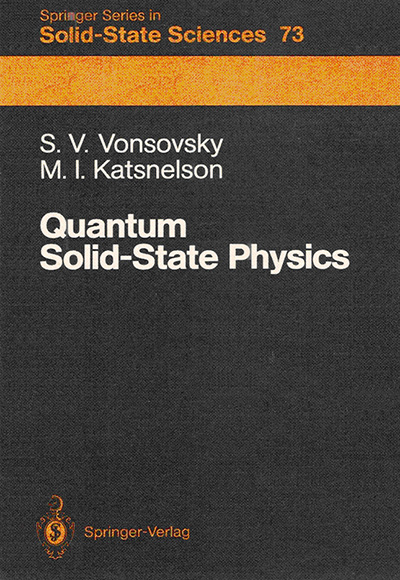Quantum Solid-State Physics

Авторы: S.V. Vonsovsky, M.I. Katsnelson
Информация о издательстве: Berlin-Heidelberg-New York: Springer-Verlag, 1989. – 505 pp.,ISBN 3-540-19103-8
The quantum theory of solids occupies a peculiar and important place in the general structure of modern theoretical physics. There are currently no grounds for questioning the statement that all properties of solids can, in principle, be accounted for on the basis of firmly established principles of quantum and statistical mechanics. Nevertheless, these properties of real solids and the condensed state of matter in general, are so complicated and diverse that it is well nigh impossible, at least at present, to explain rigorously and fully from first principles the observed characteristics of crystals, even those which are close to perfect, - let alone explain the fact that they exist! Therefore, alongside the mathematical methods and physical concepts applied in other more fundamental areas of theoretical physics, solid state theory has developed approaches of its own to account for the most important properties of the various substances. Significantly, these approaches now have a profound reciprocal effect on not only statistical physics but also on particle physics, and even on astrophysics and cosmology. Apart from this, the tremendous and ever-increasing applied significance of solid-state theory must be noted. Suffice it to mention here the theory of semiconducting devices, the theory of strength and plasticity, the theory of magnetic properties of materials, etc. In this respect, modern solid-state theory employs with great practical success a sufficiently simple and, at the same time, adequate theoretical background, based on a purely phenomenological approach and microscopic models that are comparatively simple in terms of mathematics and very lucid physically.
As stated above, a quantum theory of solids that realizes the “first-principles” program in its entirety, i. e., a theory in which all properties of solid are derived from those of individual constituent atoms, does not exist. However it may well be assumed that, for example, the indubitable and sizable success of the pseudopotential method that now enjoys wide use in the theory of simple (normal) metals is an important step toward the construction of such a physically consistent first principles theory. Rather than choosing the deductive method of presentation, we have therefore opted, in this text, for a method based on a treatment and analysis of simple empirically established properties of solids, resorting to more соmplicated models only where necessary. In a way, such an exposition reproduces the evolution of this important province of modern theoretical physics (differing in this respect from the diverse monographs and textbooks devoted to the problem concerned) and, in our view, is most appropriate to initiate the reader into the subject. We have also assumed that a detailed treatment of a number of classical topics such as the one-dimensional Schródinger equation with a periodic potential, the metal-insulator criterion, the effect of electric and magnetic fields on electronic states, and other similar problems would be very instructive. At the same time, the book presents a number of up-to-date topics: the scattering of neutrons by the crystal lattice, plasma and Fermi liquid effects, elements of pseudopotential theory, fundamentals of the theory of disordered systems, etc.
It is assumed that the essentials of quantum and statistical mechanics are a sufficient theoretical background for reading this text. As far as possible we have tried to outline the body of mathematics in conjunction with those specific problems in which it is immediately exploited. Thus, for instance, the secondary quantization method is expounded for the first time in connection with the problem of neutron scattering on phonons, the resolvent (Green’s-function) method is outlined in connection with the problem of electron localization on impurities, etc. The presentation of a number of problems, in which allowance for correlation effects in electronic systems (superconductivity, the properties of transition metals, and the like) is essential, has turned out to be extremely concise, for we did not succeed in finding a simplified enough version of the mathematical sophistication needed for a more rigorous exposition. In those (and some other) cases we had to confine ourselves to simple model problems and often to purely qualitative lines of argument.
Although the present book outlines sufficiently general properties of solids, as well as some specific problems of the physics of semiconductors, ionic crystals, etc., it is still primarily the metal that we view as the model of “a solid in general.” This is partly because the metal is in essence a gigantic molecule and demonstrates most dramatically he features peculiar to the electronic properties of crystals, which are not reducibl to a mere “sum” of the properties of individual constituent atoms or molecules.
An acquaintance with this text should prepare the reader for a more detailed study of particular areas of solid-state theory, which at present are outlined fully enough at an up-to-date level in the abundant body of special literature. The text is intended to appeal to experimental physicists, chemists, engineers concerned with problems of solid-state theory and wishing to become conversant with the pertinent body of mathematics theoretical physicists in other fields, and undergraduate and graduate students.







 Телеграм канал
Телеграм канал Группа Вконтакте
Группа Вконтакте